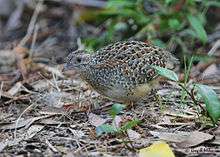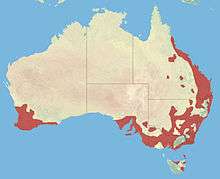Painted buttonquail
| Painted buttonquail | |
|---|---|
 | |
| Scientific classification | |
| Kingdom: | Animalia |
| Phylum: | Chordata |
| Class: | Aves |
| Order: | Charadriiformes |
| Family: | Turnicidae |
| Genus: | Turnix |
| Species: | T. varius |
| Binomial name | |
| Turnix varius (Latham, 1801) | |
 | |
| Distribution of the Painted Button quail | |
| Synonyms | |
| |
The painted buttonquail (Turnix varius) is a species of buttonquail, the family Turnicidae, which resemble, but are unrelated to, the quails of Phasianidae. This species is resident in Australia where numbers are believed to be in decline. A subspecies, the Abrolhos painted buttonquail (Turnix varius scintillans), is endemic to the Houtman Abrolhos islands.
Taxonomy
The painted buttonquail was first described by the English ornithologist John Latham in 1801 under the binomial name Perdix varia.[2]
Description
The painted buttonquail is about 19 to 20 cm (7.5 to 7.9 in) long. It is a ground-dwelling bird and is found in grassy forests and woodlands. It feeds on insects and seeds, and the males incubate the eggs for a fortnight and then care for the young.
The female is the more brightly coloured of the sexes. Her eyes are red, and her crown, face and breast are flecked with white. Her shoulders are chestnut with thin white streaking above them. The male is slightly smaller and duller in colour.
Distribution
The painted buttonquail is native to Australia. Its range extends from Queensland southwards to New South Wales, Victoria, South Australia and Tasmania. A separate population is present in the southwestern part of Western Australia. The subspecies Turnix varius scintillans is endemic to the Houtman Abrolhos islands off the west coast of Australia. Another subspecies, Turnix varius novaecaledoniae was endemic to New Caledonia but is believed to be extinct as it has not been recorded since 1912.
Status
The painted buttonquail has a wide range. An estimate of the population size has not been made but numbers are suspected to be in decline. It is said to be common in suitable habitat in some areas and uncommon in others. The IUCN has listed it as being of "Least Concern".[3]
References
- ↑ BirdLife International (2012). "Turnix varius". IUCN Red List of Threatened Species. Version 2013.2. International Union for Conservation of Nature. Retrieved 26 November 2013.
- ↑ Latham, John (1801). Supplementum indicis ornithologici sive systematis ornithologiae (in Latin). London: Leigh & Sotheby. p. lxiii.
- ↑ "Species factsheet: Turnix varius". BirdLife International. Retrieved 2013-12-16.
- Painted Buttonquail (Turnix varius) (Latham, 1801) Avibase 2009
External links
| Wikimedia Commons has media related to Turnix varius. |
| Wikispecies has information related to: Turnix varius |
